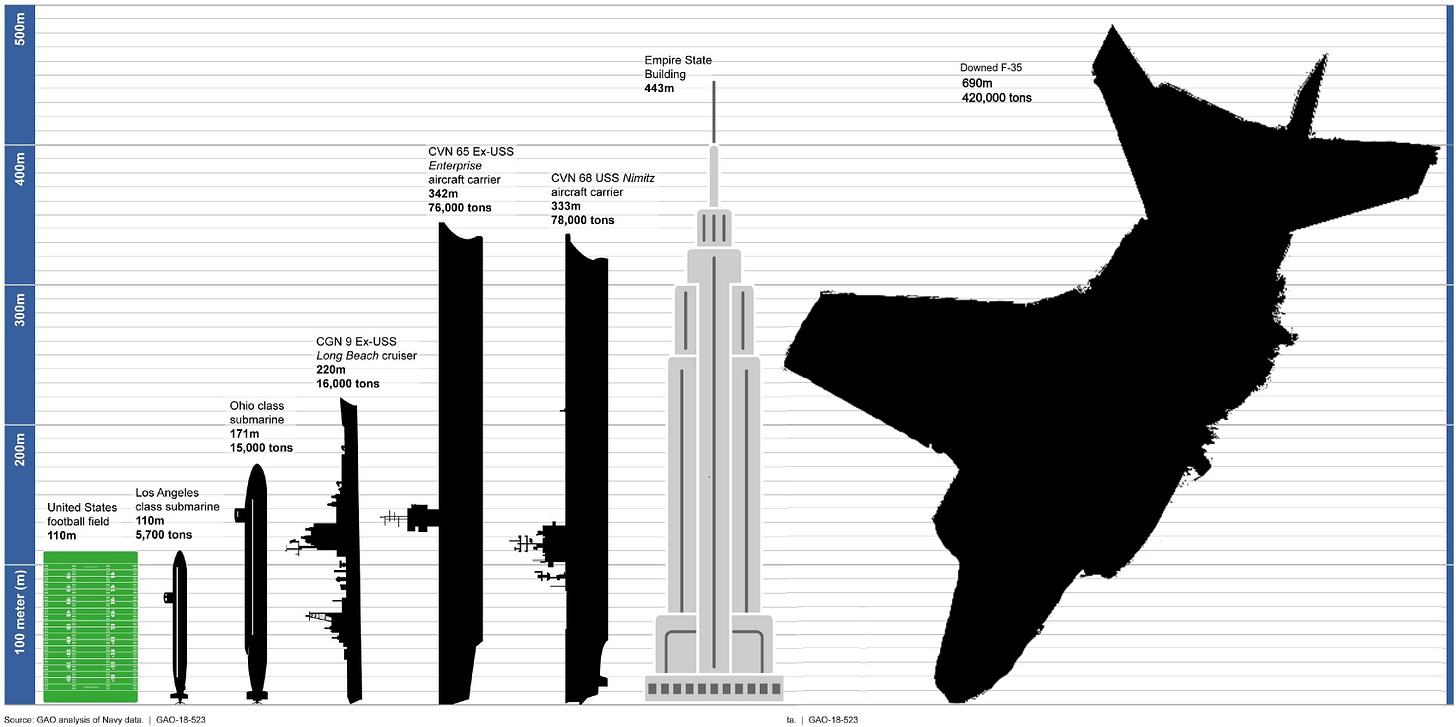Missiles and Markets
From bank hacks to bunker busters—this is what modern war looks like.
Good morning!
Alright, it’s been a busy week and we’ve a lot of ground to cover. Let’s start with the State of the Defense Tech and Dual-Use Market.
The State of the Defense Tech and Dual-Use Market
This week saw some massive funding rounds—three venture rounds over $500M, and two more over $100M. European defense AI company Helsing is doing its best to keep pace with Anduril, which has a 4 year head start on its cousin. Helsing raised nearly $700M at a $13.7B valuation—roughly where Anduril was a year ago (note that Anduril announced a raise earlier this month at a $30B valuation). Other massive rounds included nuclear tech company TerraPower ($650M), Applied Intuition ($600M at a $15B valuation), Gecko Robotics ($125M), and Mach Industries ($100M at a $470M valuation). That puts total defense / dual-use tech fundraises above $5.5B in the past 20 days!
At the same time, there’s plenty of activity around M&A in defense too, with several notable rounds this week including a potential sale of German defense-tech Vincorion at a $1.2B price and the acquisition of Edge Autonomy for about the same price. Last week, Baker Hughes’ agreed to sell its precision sensors and instrumentation business for $1.2B.
That’s nearly $10B in total transactions between VC and PE in June alone.
That should make us all ask, what’s behind this acceleration?
It would be easy to point to increased instability as exemplified by the week long Iran-Israel war as the prime driver. And, while increased instability unquestionably underlies the growing need for defense innovation (as we’ve written about for years), we can’t attribute this dramatic deal flow to Iran-Israel.
Most of these deals were probably in the works for months.
Which raises questions then of market saturation. Questions like:
How close are we to having too many defense tech companies?
How sustainable is the current funding level and valuations?
Where does the market go from here?
How can the many companies competing in this space provide returns on investment through commercialization if / when contract awards do materialize?
We’re not trying to dissuade founders and investors. We NEED innovative technologies and companies making big bets, taking big swings, and solving hard problems.
Here’s some thoughts on the future of the space:
Consider consolidation / exits. As the space continues to grow saturated, there is an emerging opportunity for limited consolidation to provide efficiencies and build more compelling products. Anduril has been much maligned recently for it’s CorpDev strategy or rolling-in innovative companies, but it’s not a bad way for them to continue to grow, improve their offerings, and accelerate innovation.
Reconsider taking that check. Not every company should take investments—even if it seems like ‘the thing to do’ or the only way to grow.
Solve the right problems. We know that you’re smart because you’re reading Building our Future. That means you’ve also go a leg up on both understanding the future of warfare and enduring nature of it, giving you insight into the right problems that need solving.
Build defensibility. Scalability and defensibility are the keys to VC-backability. They’re also key to success beyond just a fund raise.
Iran-Israel War
The Iranian-Israeli conflict has entered into its second week. Iran’s missile attacks are growing thinner as Israel has destroyed much of the necessary infrastructure inside of Iran. Israel continues to target both military facilities (especially in Western Iran, which pose the greatest risk to Israel aircraft and homeland) and nuclear facilities.
There are questions whether Israel has the necessary munitions to destroy hardened and deeply-buried targets hosting nuclear capabilities—particularly uranium enrichment. These facilities may be buried as deeply as 80m+. The largest conventional or non-nuclear munition in the west is the GBU-57 Massive Ordnance Penetrator (or MOP), weighing approximately 30,000lb. Israel does not possess these bombs but the U.S. does, which is why Israel wants the U.S. to join their war.
As an aside: we commend President Trump for judiciously and prudently not jumping into the war.
Even should the U.S. get involved, there’s some debate about whether the GBU-57 can penetrate to the depths necessary to destroy Iran’s nuclear facilities. The U.S. claims that the GBU-57 can penetrate up to 60m of concrete with a compressive stress of 5,000psi. Iran claims that it has the ability to make concrete with a compressive stress of 30,000psi. So, this becomes a giant, nerdy math problem to determine how much concrete covers the facilities compared to how much dirt and what not. Suffice to say, it’s not clear if a GBU-57 would succeed alone.
The President says that he will continue to wait before making a decision whether or not to actively participate in strikes against Iran. He claims he will make a decision in the next two weeks.
A few other important observations from the war:
Politico defense reporter Jack Detsch reported that GEN Erik Kurilla is calling the shots currently on Iran and that SECDEF Pete Hegseth is deferring to Kurilla. Under Kurilla, CENTCOM is trying to snatch up all available resources from other combatant commands highlighting both the reality of a resource-constrained military and the criticality of a global resource integrator that can make quick decisions about who gets what during a global war.
Israel and Israeli-linked hackers have conducted several important cyber attacks against Iran and in particular against Iran’s non-military systems. For example, Israel attacked Iranian bank Sepah, deleting a significant amount of data. This reminds us of Korean War activities described by Ben Malcom in his book White Tigers. These sorts of non-traditional attacks (against banks, energy grids, et al) serve to shake a population’s confidence in its government, provide illicit funds for proxies and guerillas, disable command and control capabilities, and open emergent attack vectors. This is an area to really watch in the future of warfare as belligerents seek to avoid force-on-force confrontation but seek ‘backdoors’ to achieve their strategic ends.
Iran has countered using GenAI to fabricate propaganda. These have been fairly crude, like an obviously fake image of a ‘downed’ Israeli F-35.
Israel’s air defenses, while largely successful, have failed to stop every Iranian missile. At this point, an estimated several dozen missiles have penetrated Israel’s defenses striking various targets in Haifa, Beersheba, Tel Aviv, and other cities. This reality underscores the impracticality of comprehensive air and missile defense—like the Golden Dome initiative.
A lesson emerging from Ukraine and reinforced by Iran is that if a country has a nuclear capability, it should never ever ever give that capability up.
As this new era of high-stakes competition unfolds, the line between the economic, technological, and kinetic dimensions of warfare continues to blur. A record-setting wave of investment is pouring into defense and dual-use tech, driven not just by geopolitical volatility—but by a growing recognition that the future will be shaped by those who can build faster, integrate smarter, and operate more resiliently across domains.
But building the future isn't just about raising capital or shipping code—it's about designing systems that endure, solving the right problems, and preparing for conflicts that won’t look like the last war. The weeks ahead will test how ready we are—for escalation, for innovation, and for the reality that the next major war may be won as much through terminals and servers as with missiles and steel.
Alright, on to the news.
News Headlines
President Trump to decide in next 2 weeks if U.S. will participate in direct attacks on Iran (AP)
Army officials splash cold water on SecDef Hegseth's claims that change in admin is solely responsible for recruiting bump (WP)
President Trump nominates Marine Gen. Christopher Mahoney as next Vice Chairman of the Joint Chiefs (DS)
EU foreign policy chief Kaja Kallas warns that Russia has a plan for long-term aggression against Europe (AP)
U.S.S. Gerald Ford to sail for European deployment, giving U.S. a 3rd carrier option if Iran-Israel war widens (TOI)
A SpaceX Starship exploded during testing at Starbase in Texas (AP)
9th Circuit Appeals Court rules that President is within his rights in federalizing the National Guard in Los Angeles (WP)
Defense & Dual-Use Technologies
Air Force shifts focus from E-7 Wedgetail to advanced E-2 Hawkeye for AEW&C mission (ASF)
Army expands 'transformation in contact' initiative to Army Guard (MT)
U.S. Navy to startups: 'we want you!' (TC)
Threat Tech
Chinese scientists claim to have built world's first 6G EW weapon (IE)
China hacks Russia looking for war secrets (NYT)
Chinese military robotics lab creates mosquito-sized microdrone for covert ops (MP)
Putin announces creation of separate military drone branch (RT)
Russia claims it is testing new laser defenses against drones (RT)
Despite close ties with Iran, Russia stands aside as Israel attacks (NYT)
Iran uses GenAI to create and circulate fake image of ‘downed Israeli F-35’ (YN)
Terrorism threat grows in West Africa as U.S. turns away (NYT)
Russia hands over blueprints for Iran's Shahed long-range attack drones to North Korea (EX)
North Korea to send military construction workers and deminers to Russia (AP)
Israel-Iran conflict likely hardens N. Korea's nuclear resolve (MP)
Report: Over half of N. Korean troops fighting in Kursk killed or injured (KP)
Foreign Defense Tech
Europeans rush for drone-based radar in effort to supplant U.S. tech (DN)
Denmark using robotic sailboats for Baltic, North Sea surveillance (AP)
Estonia plans to deploy a 'drone wall' by 2027 (DS)
Pro-Israel hackers took credit for $90M theft from Iran's biggest crypto exchange (NBC)
Suspected Israeli hackers claim to destroy data at Iran's Bank Sepah (RT)
Israel's spy agency used AI and smuggled-in drones to prep attack on Iran (AP)
After years of criticizing U.S. drone strikes, Pakistan seems to be embracing them as it wages a campaign against militants including Tehrik-e-Taliban Pakistan (TTP) and the Balochistan Liberation Army (NYT)
Sweden's military joins Telia, Ericsson to boost defense tech (RT)
Tashkent looks to Beijing for 5th Gen fighters reflecting regional shifts (TCA)
Defense Industry
Airbus mulls boosting tanker production on 'very high' demand (DN)
Taiwan, Auterion sign MoU for drone swarming software (BD)
Consortium building Eurofighter focused on 'combat mass' over next-gen buzz (DN)
MBDA offers cheap drone swarms as door opener for pricey missiles (DN)
Unmanned Leonardo jets trainers could take GCAP drone role: CEO (DN)
Oracle unveils initiative to help companies sell tech to the DoD (WSJ)
Thales, Skydweller to offer solar-powered drone for month-long patrols (DN)
Autonomous Systems
Northrop, ShieldAI, others launch Beacon autonomy partnership using Model 437 aircraft (AX)
Taiwanese, U.S. firms display latest uncrewed surface vessel tech with military potential (MP)
North Koreans fighting for Russia against Ukraine have grown skilled in drone warfare (NPR)
Finance & Deal Flow
Funds
French alternative asset manager Tikehau Capital teamed with three insurers to launch a $175M PE fund focused on European defense and cybersecurity (RT)
VC
European defense tech startup Helsing raised a $690M round at a $13.7B valuation led by Prima Materia, the VC firm of Spotify CEO Daniel Ek (TC)
Nuclear innovation company TerraPower raised a $650M round from NVentures, HD Hyundai, Bill Gates, and others (GW)
Autonomous vehicle software startup Applied Intuition raised a $600M Series F at a $15B valuation led by BlackRock and Kleiner Perkins (TC)
Gecko Robotics raised a $125M Series D led by Cox Enterprises for robotic inspection of critical infrastructure, including ship hulls (SA)
Rising defense tech star Mach Industries raised a $100M round at a $470M valuation led by Khosla Ventures and Bedrock Capital (PRN)
Bengaluru-based defense tech startup Sanlayan Technologies raised $22.4M in a Series A led by Ashish Kacholia (TIA)
Onebrief, a software for military staff collaboration and operational planning, raised a $20M Series C extension at a $1.1B valuation led by Battery Ventures--doubling its valuation in 3 months (BW)
PE / M&A / Exits / Other
Japan's Nippon Steel closed its $14.1B acquisition of US Steel, ending an 18-month takeover saga marked by political scrutiny and domestic opposition (BW)
Star Capital is considering an IPO of German defense tech firm Vincorion at a potential $1.2B valuation (BBG)
Redwire concludes its acquisition of Edge Autonomy from Sleeping Bear Capital for $1.15B, deepening its defense and space offerings (PEH)
India's largest port in the making Vadhavan Port is seeking to raise $3.5B in onshore and offshore debt (IB)
Exciting Opportunities
The Army is looking for advanced, deployable defensive cyberspace operations capabilities including passive and active such as hunting for advanced internal threats (SAM)
The National Geospatial Intelligence Agency is looking for service focused on measuring surface optical properties and bulk properties of materials, developing models to create signatures of interest, and curating databases (SAM)
The Army wants to create a small, counter-drone system that any soldier can operate and provide protection using EW or lasers (SAM)
The Strategic Capabilities Office is seeking non-traditional industry partners in the development of an undersea weapons program and is interested in additive manufacturing, AUVs, electric propulsion, battery tech, and more (SAM)
The British MoD is seeking to assess and mature a suite of capabilities of deriving PNT within GNSS denied or degraded environments (DSP)
Editor's Picks
Visiting lecturer at the Diplomatic Academy of Ukraine Alina Hrytsenko and German Council on Foreign Relations senior fellow Andras Racz conclude that China's desire for strategic autonomy will trump any partnerships with Russia.
Marine Corps officers Lt Col John Dick and Lt Col Daniel Phillips want the Marine Corps to take over the M-10 Booker light tank that the Army is cancelling.
Observer Research Foundation research assistant Abhishek Sharma argues that North Korea's military modernization drive extends beyond the warship that capsized on launch.
Lighter Side
Keep Building,
BOF







